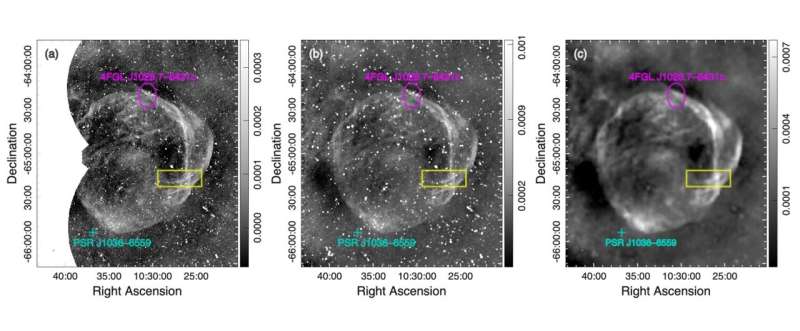August 28, 2023 report
This article has been reviewed according to Science X's editorial process and policies. Editors have highlighted the following attributes while ensuring the content's credibility:
fact-checked
preprint
trusted source
proofread
New supernova remnant detected with ASKAP

Using the Australian Square Kilometer Array Pathfinder (ASKAP), an international team of astronomers has serendipitously detected a new Galactic supernova remnant (SNR), which received designation SNR G288.8–6.3. The finding was reported in a paper published August 17 on the pre-print server arXiv.
SNRs are diffuse, expanding structures resulting from a supernova explosion. They contain ejected material expanding from the explosion and other interstellar material that has been swept up by the passage of the shockwave from the exploded star.
Studies of supernova remnants are important for astronomers, as they play a key role in the evolution of galaxies, dispersing the heavy elements made in the supernova explosion and providing the energy needed for heating up the interstellar medium. SNRs are also believed to be responsible for the acceleration of galactic cosmic rays.
Now, a group of astronomers led by Miroslav D. Filipović of the Western Sydney University in Australia reports the discovery of a new nearby SNR. The finding was made using 36 ASKAP antennas at the central frequency of 943.4 MHz and bandwidth of 288 MHz, as part of the ASKAP-Evolutionary Map of the Universe (EMU) survey.
"We have serendipitously found a large-scale object in our new ASKAP-EMU survey, which we classify as the new Galactic SNR G288.8–6.3," the researchers wrote in the paper.
SNR G288.8–6.3 has an intrinsic size of about 130 light years and a spectral index of -0.41—typical for known SNRs. The remnant is located some 4,200 light years away from the Earth and is positioned about 456 light years above the Galactic plane. Therefore, SNR G288.8–6.3 turns out to be one the largest and closest Galactic supernova remnants.
The spectral index of SNR G288.8–6.3 suggests that this remnant represents the evolutionary advanced SNR population in the late adiabatic or in the radiative phase of evolution. Moreover, SNR G288.8–6.3 has a relatively low radio surface brightness, what, together with other properties, points to an age of about 13,000 years.
According to the paper, shock-compression of the magnetic field in SNR G288.8–6.3 is sufficient to produce large enough magnetic fields to explain the synchrotron emission of the SNRs. Furthermore, based on the study of neutral atomic hydrogen (HI), the astronomers found a cavity-like distribution and possible evidence for the shock-cloud interaction in this remnant.
Summing up the results, the authors of the paper propose further in-depth polarimetric and multifrequency observations of SNR G288.8–6.3 in order to get more insights into the nature of this intriguing newfound SNR.
"Future in-depth polarimetric and multifrequency studies will enhance our knowledge of this large angular size Galactic object," the researchers concluded.
More information: Miroslav D. Filipović et al, EMU Detection of a Large and Low Surface Brightness Galactic SNR G288.8-6.3, arXiv (2023). DOI: 10.48550/arxiv.2308.08716
Journal information: arXiv
© 2023 Science X Network




















